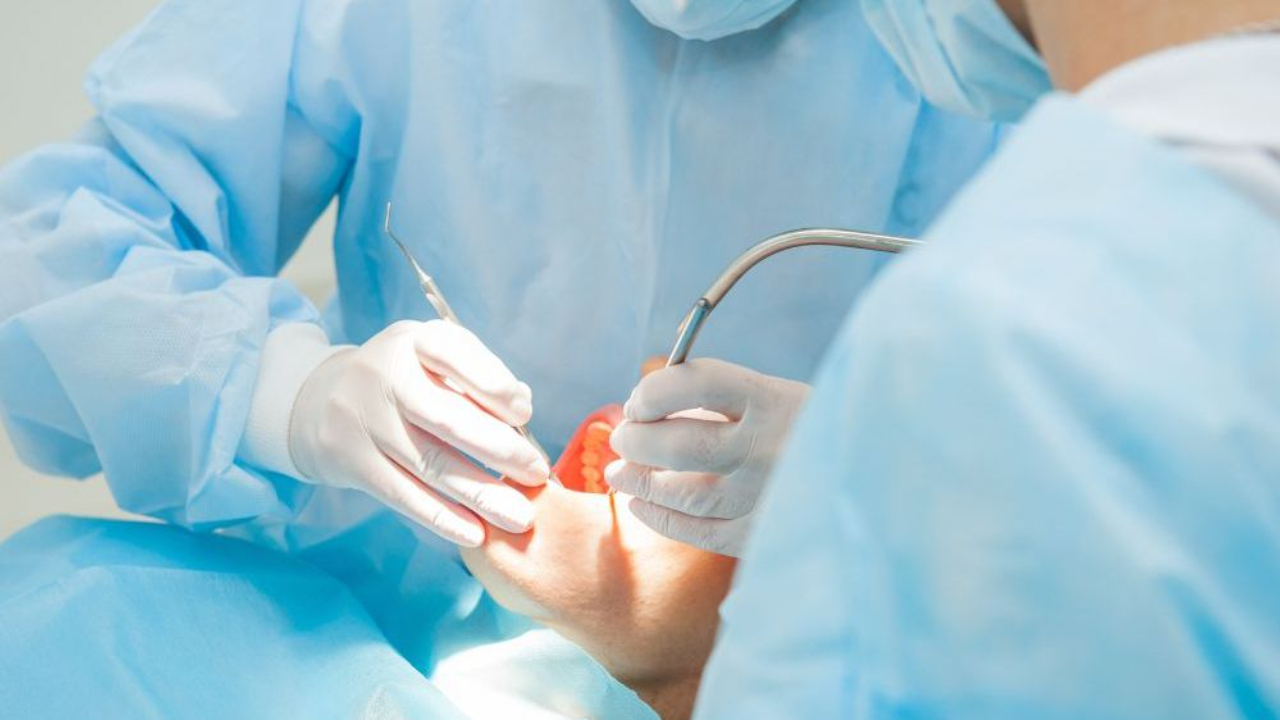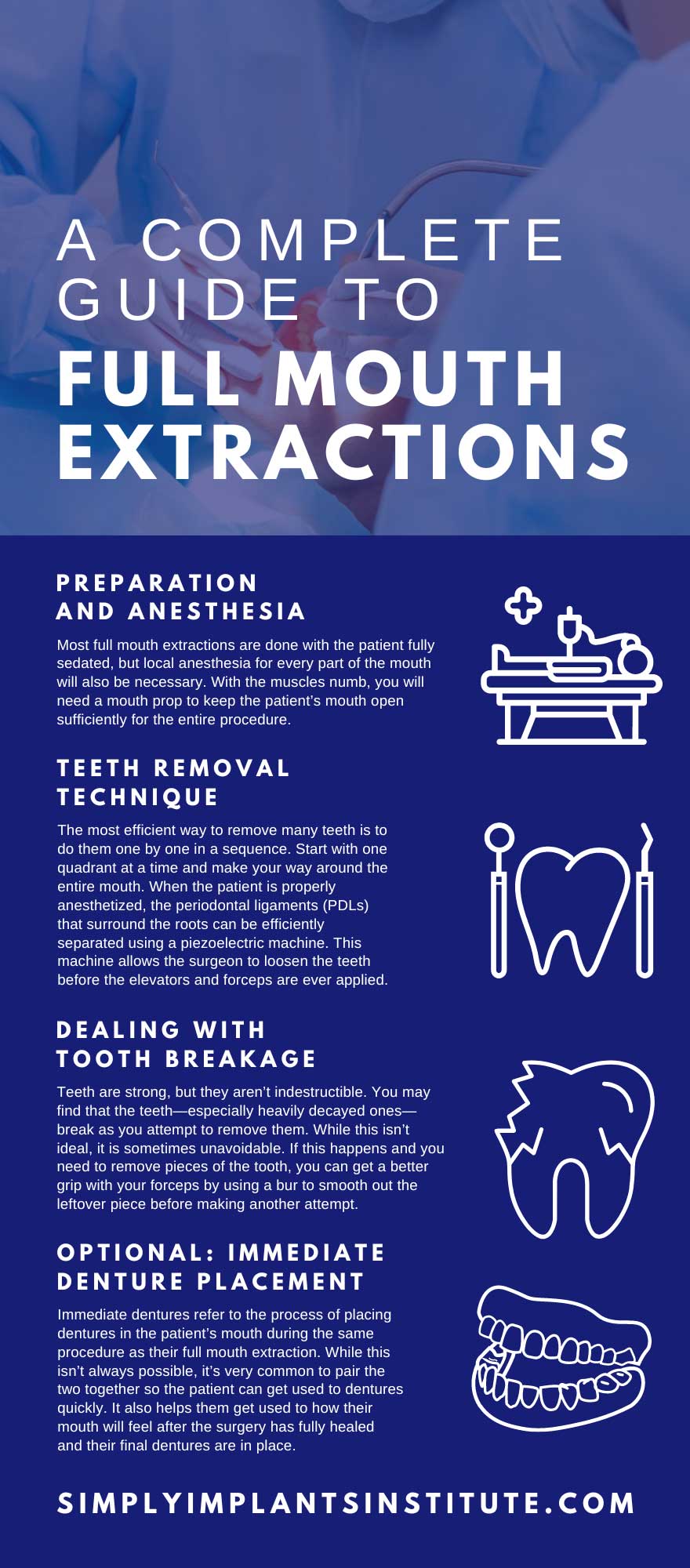A Complete Guide to Full Mouth Extractions

No patient has ever wanted to hear that the best option for them is a full mouth extraction. No matter how someone feels about their teeth, they are a huge part of who we are and how we present ourselves. Knowing this, it’s easy to understand how the idea of a full mouth extraction can put off a patient, even if it is in their best interest.
As a dentist, it’s your responsibility to make the call when a full mouth extraction is justified. The idea of a full mouth extraction will almost always make a patient nervous unless they are already in unbearable pain. The procedure’s cost or how much pain and suffering they will go through can make patients extremely uncomfortable and worried.
A professional dentist should be able to perform the procedure confidently and adequately explain the necessity and benefits of the procedure to their patients. This complete guide to full mouth extractions will prepare you for what the procedure entails and present tips to keep your patients comfortable throughout the process.
When Is a Full Mouth Extraction Necessary?
Because a full mouth extraction removes every one of a patient’s teeth, there needs to be sufficient circumstances to warrant such a procedure. For most patients, this usually happens because of extensive damage to multiple teeth, heavy periodontal decay, or widespread tooth infection. The root causes of these issues can vary from poor diet to poor hygiene habits to hereditary problems. When a patient can no longer reliably chew food or talk comfortably, it’s a good time to discuss a full mouth extraction.
Assuaging Patient Fears
As we’ve already mentioned, the idea of a full mouth extraction can put most patients on edge. Thinking about the procedure or dealing with the aftermath can make even the toughest patients a little wary. Beyond the procedure itself, a good dentist will be able to assuage a patient’s fear about the procedure.
The best way to do this is to focus on the positives that come with the procedure being over and done with. Your patient is likely in serious pain on a regular basis, and they can finally be free of that pain after the procedure is done. If they are uncomfortable with or self-conscious about how their teeth look, focus on describing how they can feel comfortable smiling again once they receive dentures or implant replacements.
Full Mouth Extraction Process
While this guide to full mouth extractions won’t go into every granular detail of the procedure, we can talk about the most important parts of each step. A full mouth extraction won’t be something you learn how to do confidently right out of school. That’s why a hands-on extraction course from Simply Implants Institute can prepare you for this long procedure. Understanding the theory of what you will do is important, but nothing will be able to replace the experience of performing extractions on real patients.
Preparation and Anesthesia
A comprehensive set of X-rays of the patient’s teeth is necessary to understand the full extent of the decay or damage to the teeth. This X-ray will also be crucial for finding periodontal issues, bone density, and existing damage. If the damage is severe enough for a full mouth extraction, you’ll ideally want to do the entire mouth in one visit to reduce the recovery time and the number of visits from the patient.
Most full mouth extractions are done with the patient fully sedated, but local anesthesia for every part of the mouth will also be necessary. With the muscles numb, you will need a mouth prop to keep the patient’s mouth open sufficiently for the entire procedure.
Teeth Removal Technique
The most efficient way to remove many teeth is to do them one by one in a sequence. Start with one quadrant at a time and make your way around the entire mouth. When the patient is properly anesthetized, the periodontal ligaments (PDLs) that surround the roots can be efficiently separated using a piezoelectric machine. This machine allows the surgeon to loosen the teeth before the elevators and forceps are ever applied. It enables the surgeon to use less lever forces once the elevators and forceps are used to remove the teeth. You never want to rush pulling a tooth, as this could cause more damage than necessary. In addition, the piezoelectric machine can reduce the chances of deep, difficult root breakages from the teeth.
A gentle, steady pressure buildup through wrist movement will give the bone around the tooth enough time to expand. Keep building up the pressure slowly, and eventually, you will feel the “pop” of the tooth disengaging from its socket. This means the periodontal ligament has fully released the tooth, allowing you to remove it.
Dealing With Tooth Breakage
Teeth are strong, but they aren’t indestructible. You may find that the teeth—especially heavily decayed ones—break as you attempt to remove them. While this isn’t ideal, it is sometimes unavoidable. If this happens and you need to remove pieces of the tooth, you can get a better grip with your forceps by using a bur to smooth out the leftover piece before making another attempt. Once the teeth are removed, the surgeon will bone graft all the extraction sites. Grafting will to do two primary things:
- Preserve bone for future implant sites if this is what the patient desires.
- Prevent those painful dry sockets that often occur when bone grafting is not done at the time of surgery.
Optional: Immediate Denture Placement
Immediate dentures refer to the process of placing dentures in the patient’s mouth during the same procedure as their full mouth extraction. While this isn’t always possible, it’s very common to pair the two together so the patient can get used to dentures quickly. It also helps them get used to how their mouth will feel after the surgery has fully healed and their final dentures are in place.
Postoperative Care Instructions
Postoperative care is absolutely essential after a full mouth extraction, and you should express its importance to your patients as much as possible. Extremely important blood clots will form in the hours after the procedure; patients should wait a full 24 hours before rinsing or spitting to prevent losing these blood clots. In the following days, carefully rinsing their mouth and dentures will fend off bacteria and prevent infection in the sensitive surgery site.
Food should be very soft and require no chewing. Patients should consume food and drink at medium temperatures, as excessive heat or cold could cause more pain.
Full mouth extractions may be long procedures, but you can get through them easily with practice. Simply Implants Institute is the best place to arm yourself with both knowledge and practice that will allow you to be the best dentist possible.

